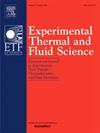The regimes of drop vaporization in saturated conditions under low pressure
IF 2.8
2区 工程技术
Q2 ENGINEERING, MECHANICAL
Experimental Thermal and Fluid Science
Pub Date : 2025-01-27
DOI:10.1016/j.expthermflusci.2025.111416
引用次数: 0
Abstract
This paper reports on a parametric study of the phenomenon of vaporization of drops deposited on a superheated wall in saturated low pressure conditions (i.e. close to the triple point pressure and in the absence of any non-condensable gas). The studied parameters were the surface temperature, the saturation pressure, the height of injection of the liquid forming the drop and the size of the injection needle. Three regimes of vaporization were observed : evaporation, rebound and boiling. The distinction between the regimes was based on the analysis of video sequences but also on the thermal signature of the process of vaporization as recorder by heat flux measurements performed by 25 heat flux sensors embedded in the heated wall.
The regime of evaporation is characterized by the progressive vaporization of the drop that keeps the shape of a spherical cap whose height and diameter decrease with time. The boiling regime may correspond to two different behaviors, both being characterized by the nucleation of a bubble inside the drop itself. In certain conditions, this bubble bursts in such a manner that the drop is atomized and many daughter drops are spread all over the heated wall (bursting bubble boiling behavior). Such burst is made possible by the large bubble diameters (up to several centimeters) that is typical of boiling at low pressure. In other conditions, the presence of the bubble slightly affects the overall phase change (soft bubble boiling) because the burst is not strong enough to disperse daughter drops. Lastly, the regime of rebound was observed only in a restricted range of operational conditions.
The time of vaporization obviously depends on the regime: the shorter times were recorded for the bursting bubble boiling behavior, owing to the dispersion of all small daughter drops that vaporize all over the surface. It was found to be longer for the behavior of soft bubble, and even longer for the regime of evaporation.
The conditions for the occurrence of the vaporization regimes were summarized on maps based on dimensionless parameters, namely the Weber number, the Ohnesorge number, a dimensionless heat flux and a dimensionless pressure.
液滴在低压饱和条件下的汽化状态
本文报道了在饱和低压条件下(即接近三相点压力且不存在任何不可冷凝气体)沉积在过热壁上的液滴汽化现象的参数化研究。研究的参数包括表面温度、饱和压力、形成液滴的液体的注射高度和注射针的尺寸。观察了蒸发、回弹和沸腾三种汽化方式。这两种状态之间的区别是基于对视频序列的分析,但也基于作为记录者的蒸发过程的热特征,即由嵌入加热壁上的25个热流密度传感器进行的热流密度测量。蒸发状态的特点是液滴的逐渐汽化,保持其高度和直径随时间减小的球形帽的形状。沸腾状态可能对应于两种不同的行为,这两种行为都以液滴内部的气泡成核为特征。在某些条件下,气泡以这样一种方式破裂,液滴被雾化,许多子液滴散布在加热壁上(气泡沸腾行为)。这种爆裂是由于气泡直径大(可达几厘米),这是在低压下沸腾的典型现象。在其他条件下,气泡的存在轻微影响整体相变(软泡沸腾),因为破裂的强度不足以分散子滴。最后,仅在有限范围的操作条件下观察到反弹的情况。汽化的时间显然取决于状态:由于所有汽化在表面上的小子滴分散,气泡沸腾行为记录的时间较短。发现软泡行为的时间更长,蒸发状态的时间更长。基于无因次参数,即Weber数、Ohnesorge数、无因次热流密度和无因次压力,在图上总结了汽化状态发生的条件。
本文章由计算机程序翻译,如有差异,请以英文原文为准。
求助全文
约1分钟内获得全文
求助全文
来源期刊

Experimental Thermal and Fluid Science
工程技术-工程:机械
CiteScore
6.70
自引率
3.10%
发文量
159
审稿时长
34 days
期刊介绍:
Experimental Thermal and Fluid Science provides a forum for research emphasizing experimental work that enhances fundamental understanding of heat transfer, thermodynamics, and fluid mechanics. In addition to the principal areas of research, the journal covers research results in related fields, including combined heat and mass transfer, flows with phase transition, micro- and nano-scale systems, multiphase flow, combustion, radiative transfer, porous media, cryogenics, turbulence, and novel experimental techniques.
 求助内容:
求助内容: 应助结果提醒方式:
应助结果提醒方式:


